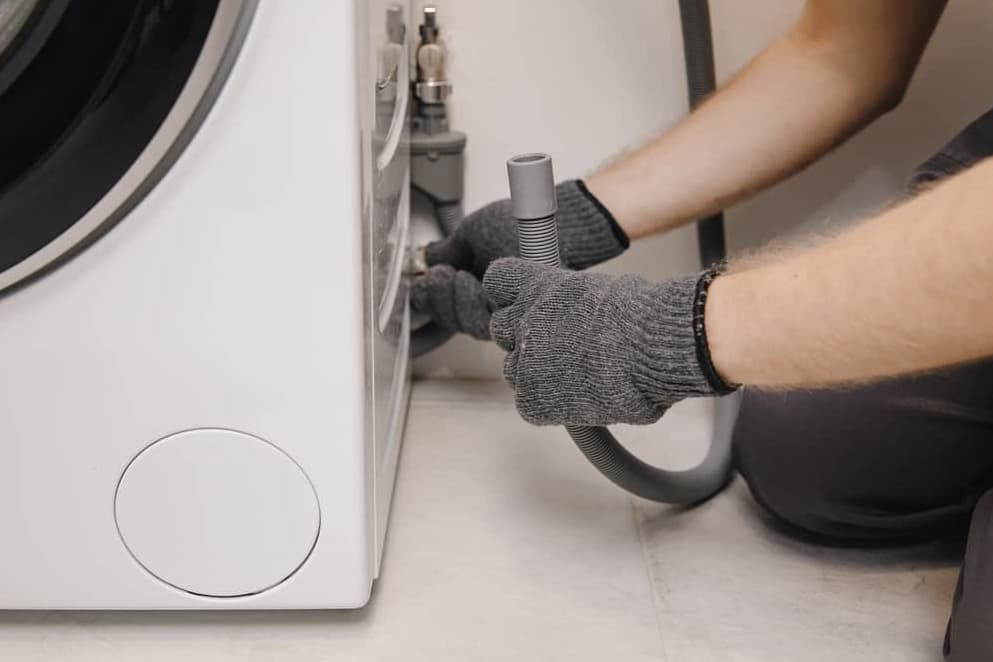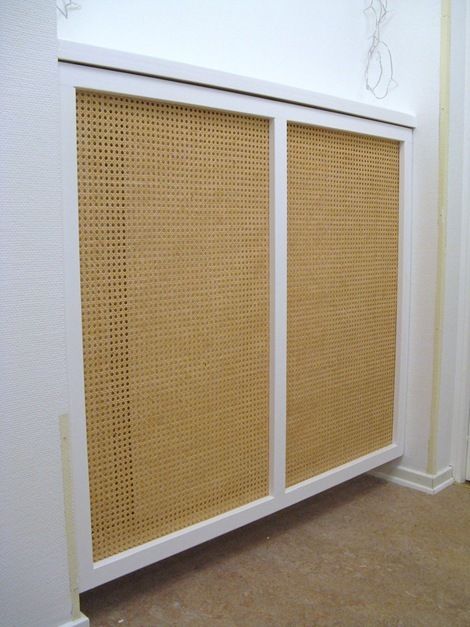If you live in a home connected to a municipal sewer system, chances are your washing machine does drain into the main sewer line. However, homes with septic tanks likely have separate gray water plumbing for the washing machine.
Understanding where your washer drains can help you maintain proper drainage and prevent backups.
Does Washing Machine Drain Into Sewer Line?

Where Do Washing Machines Drain?
The drainage destination for your washing machine depends on what kind of wastewater system your home utilizes:
- Municipal sewer system homes – Washing machines typically drain into the main household sewer line along with sinks, showers, toilets, etc. From there, the wastewater flows to a municipal treatment plant.
- Septic system homes – It is important not to drain washing machines directly into the actual septic tank. Instead, rural households often install separate gray water systems to handle laundry machine drainage.
Gray water systems for washing machines frequently utilize an underground dry well that distributes the water into the soil. Detergents and soaps from laundry are not hazardous to the environment, so this water can safely percolate back into the ground.
Diverting washing machine drainage away from the main septic tank helps prevent premature outflow to the drainage field and eliminates strain on the tank.
“If you live in a city or subdivision with a municipal sewer system, then water from your washing machine flows to the same sewer line that your toilets, sinks, and showers drain into.
This is the main sewer line. From there, the water will flow to a treatment plant. This is common in urban and suburban homes.”
Understanding whether your household utilizes a municipal sewage system or a septic tank system is the first step in identifying your washing machine drainage route.
In municipal sewer contexts, washing machine water travels to the general wastewater treatment infrastructure that serves sinks, showers, etc.
However, caution needs to be taken with septic system homes to divert laundry water away from the main septic tank.
Should Washing Machines Drain Into Septic Tanks?
Draining washing machine water into a septic tank is an extremely bad idea and should be avoided. There are several risks associated with allowing your washing machine to drain into a household septic tank:
- Blockages – The large volume of water discharge from a washing machine can stir up solids inside the septic tank. This can lead to premature pushing of waste into the drainage field before liquids have adequately separated. It also increases the chances of solids collecting around outlets and inlet pipes, causing clogs.
- Strain on drainage field – Laundry drainage water can force septic tank waste into the drainage field before proper separation of liquid and solid sewage. This strains the soil absorption capacity and causes flooding issues.
- Premature waste outflow – Washing machine water adds significant volume to the septic tank. The excess liquid then forces waste to exit the tank faster than the rate intended by design. This strains the drainage field.
- Sewage backups – Any blockages or issues caused by washing machine linkage to the septic tank can result in sewage backups into the home. Preventing washing machine connections protects health.
“Washing machines should not be drained to your septic tank. Draining your washing machine into your septic tank can cause blockages or may cause waste to flow out of your septic tank and into the drainage field prematurely. This can release sewage onto your property, which puts your family’s health at risk.”
To avoid septic system problems, washing machines in households with septic tanks must utilize separate gray water systems. These safe diversion systems take the form of dry wells, leach pits, or drain fields specifically intended for laundry water.
By keeping washing machine drainage segregated from septic flow, rural homes can safely and sustainably process laundry water.
How to Determine Washing Machine Drainage Flow
If you need to figure out precisely where your washing machine drains to, there are a couple of methods to determine the drainage route:
Underground Utility Mapping
In the United States and Canada, you can contact the 811 “Call Before You Dig” number to request professional underground utility mapping on your property. Trained technicians will visit your home and use specialized equipment to locate and mark buried pipes and cables on your land. This helps indicate piping routes to disambiguate drainage flows:
- Marked utility lines show if washing machine pipes connect to main household drains or separate gray water systems.
- The service is completely free as a public safety offering.
- Professional drainage mapping is far more accurate than guesswork.
“You can find out where your washing machine drains by contacting the free 811 service in the United States and Canada. If you contact this service, they will send a professional out to mark underground utility lines on your property, at no cost to you. This can help you determine where your washing machine drainage pipe runs.”
Plumber Inspection
You can also choose to hire a professional plumber to inspect your household drainage system and diagnose your washing machine connection.
The plumber has specialized tools like pipe cameras to get a firsthand view of piping routes throughout your property. They can definitively indicate whether your washing machine ties into septic tank pipes or separate wastewater systems.
This also allows you to get a professional opinion on any issues noted with your current setup.
Do Washing Machines Need Individual Drain Pipes?
All washing machines require an individual drain standpipe for correct water removal. This standpipe should feature the following:
- A 2-inch diameter PVC pipe size for most residential washing machine models.
- A height between 18 to 30 inches above the floor.
- Vented design to prevent siphonage or backflows.
- Direct downward routing to the house drain or gray water system.
The individual standpipe is crucial because washing machines discharge high volumes of water very rapidly.
Attempting to drain dozens of gallons into a standard pipe shared with other fixtures would be problematic. The result could be overwhelming the drainage capacity or disturbing connections with other appliances.
Instead, having a dedicated 2-inch standpipe sized specifically per clothes washer engineering provides confidence in drainage capability. The venting also maintains proper air pressure within drainage pipes during rapid water flows.
This further reduces the odds of disturbing other household fixture connections from washing machine drainage.
“A washing machine must be drained to a vented standpipe, to allow for proper drainage. The standpipe must run to the sewer line or to a gray water system for your home. A properly installed and vented pipe prevents premature drainage and backflow.”
Finally, correctly installing new washing machines involves tying the drain hose directly into the standalone laundry pipe. The purpose-built standpipe then carries the water away efficiently. This method is vastly superior compared to improvised connections to bathroom or kitchen sinks. Sink piping lacks capacity and risks appliance linkages backing each other up.
Can Sewage Back Up into a Washing Machine?
In certain situations, yes – sewage water can sometimes back up from drainage pipes into a washing machine:
- Sewer line clogs – Drainage blockages downstream of the washing machine connection cause water to dam and flood backward up the pipe. Tree roots, grease buildup, and loose pipe fittings can all cause main drain clogs.
- Improper plumbing – Incorrect drain configurations allow wastewater to backflow when air pressure changes or high volumes enter pipes. Misaligned joints or lack of venting causes problems.
- System overload – Municipal sewer systems overwhelmed with stormwater or municipal drainage failures can also cause public system water to back up into household plumbing fixtures.
Sewage backing up into your washing machine is a serious health hazard as well as a source of contamination for clothes. Exposure to gray water from sinks or showers would damage fabrics as well. Any appearance of blackwater suggests septic or municipal sewage intrusions.
In all cases, call an emergency plumber promptly before using the washing machine again or testing drainage flows. The plumber can diagnose the failure point and rectify drainage to prevent future overflows into the appliance.
“Sewage water can back up into your washing machine for several reasons. A clogged sewer line is a common cause of sewage backup in a washing machine. Improper plumbing installation can also cause sewage to back up into your washer.”
Until the underlying problem is repaired, refrain from using a washing machine that has experienced a sewage overflow. The additional water volume from laundry appliance usage could worsen the structural drainage issue. Diagnosing and correcting the root cause of backups is crucial.
Reasons for Sewage Odor from Washers
If your washing machine or laundry room emanates a rotten egg or fecal-like smell, a few key explanations exist for the sewage odor:
- Clogged Drainage Pipes
Blocked drains downstream of the washing machine are a common source of unpleasant sewage gases entering the appliance. Clogs prevent wastewater from fully exiting the property, causing accumulated solids to rot and produce methane sewer gas. Confirm all household drains flow adequately without flooding back up when tested.
- P-Trap Configurations
The P-trap piping underneath sinks and washing machines is meant to hold water and block airborne gases from entering living spaces or appliances. However, if improperly positioned, methane can bypass the water barriers. Call a plumber to inspect P-trap alignments if smell complaints localize around the washing machine.
- Nearby Sewage Leaks
Failures in household drain lines or external municipal connections can also introduce unpleasant gases. Shadow your property’s buried sewage pipes looking for pools of flooding wastewater indicating a cracked pipe leaking soils and gases upwards. Confirm your home’s pipes first before assuming broader system issues.
Address sewage smells within days to protect health and minimize corrosion damage to plumbing from methane exposure. In most cases, a licensed plumber can examine drainage specifics to diagnose the issue. They can then implement structural repairs or install venting systems to remove unpleasant gases.
“Improper washing machine P-trap height can contribute to a sewage smell.”
Refrain from ignoring sewage smells around your laundry equipment. Seeking professional drainage troubleshooting quickly helps resolve problems before major damage occurs.
Is the Washing Machine Connected to the Toilet?
Sometimes homeowners misunderstand basement or utility room plumbing and wonder if their washing machine somehow ties into toilet drainage pipes. However, modern building codes and correct installation procedures always mandate washing machines to connect to designated standpipes.
These standpipes then feed separately into the main household drainage line exiting the property. The toilet waste line connects to this same general household pipe. Yet there are no direct connections between washing machine plumbing and specific toilet lines. Both fixtures drain fully independently into the broader plumbing drainage infrastructure.
The only overlap between the washing machine and toilet outflow exists in municipal sewer mains that serve entire neighborhoods. As mentioned earlier, verifying your particular household setup comes down to either a:
- Municipal sewer system – Washing machine water merges with all household drains, including toilets, at some point in the municipal sewage system upon exiting your property line.
- Septic drainage – Washing machines route into gray water pits or wells separate from central septic tanks. Only toilets connect directly to the septic system.
In either context, no cross-contamination or direct joins exist between the washing machine and toilet drainage pipes inside the home. Both fixtures simply link into the larger residential drainage pathways specific to the type of sewer system in use. The similarities end there until both outflow types converge at municipal sewage plants.
Additional Washing Machine Drainage FAQs
-
What causes the washing machine drain to overflow by the wall?
If you experience washing machine water overflowing from wall connections or standpipe joints, this typically indicates a partial clog. Drain hoses, standpipes, and connecting joints can all develop debris blockages. Clear obstructions fully and test flows to confirm smooth drainage without overflows before using the machine again.
-
How do you clean out a clogged washing machine drain pipe?
Use a long auger snake to fish out trapped debris inside washing machine drain pipes. Feed the rotating auger until you feel the clog resistance. Pull out debris and retest drainage flows. You can also try drain cleaners, boiling water, or mild acid solutions to dissolve blockages after disassembling pipe joints.
-
Why does my sink gurgle when the washing machine drains?
Loud gurgling noises from the sink during washing machine drainage usually indicate issues with drain venting that allow air pressure fluctuations in the pipes. Venting issues can siphon water from sink traps. A plumber can diagnose vent deficiencies and restore proper pressure equilibrium between drains.
-
How can I stop my washing machine from backing up into the sink?
If washing machine water overflows into sinks, inspect drainage lines for obstructions that dam water during rapid machine discharge. Also, have a plumber evaluate the overall plumbing venting. Inadequate venting creates pressure imbalances that can redirect water the wrong way through drains. Proper venting is crucial to segregate fixture drains.
-
What causes washing machine drainage overflows?
Overflows during the washing machine drain cycle typically occur when drainage pipes grow partially blocked by lint accumulation, soap buildup, or protruding joints that catch debris. Regularly cleaning pipes and filters prevents overflow incidents. Also, inspect joints for smooth/aligned fits.
-
Why does water drain out while my washing machine is filling?
If water immediately drains from a washing machine during the fill cycle, the water inlet valve requires replacement. Faulty valves can stick open, allowing uncontrolled water flow that exceeds the tub capacity and directly outlets through the drain. A technician will need to replace the entire valve.
Also Check: How to Tell If Washing Machine Control Board is Bad
Conclusion:
Knowing exactly where your washing machine drains, and avoiding connections to septic systems, ensures proper performance and longevity of your household drainage system.
While regular laundry appliance usage and drainage seems trivial, following best practices for isolating washers protects against very serious sewage backflows, unpleasant gas odors, and water damage over time. Investing in the right drainage planning reduces headaches.
The direction laundry water takes upon exiting your washing machine may feel abstract or hidden within pipe network complexities. Yet identifying how washer water ultimately flows, and intentionally diverting it if on private septic systems, prevents very real problems down the road.
Purposefully mapping piping runs using professional assistance provides useful drainage system transparency.


